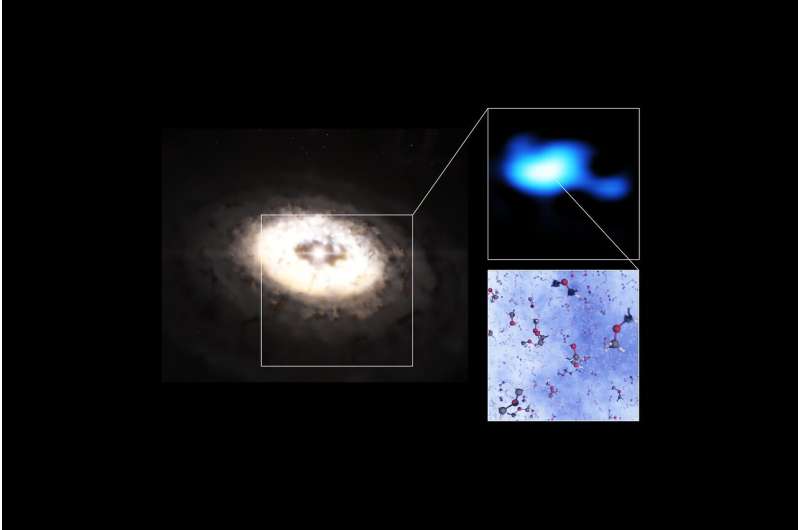
Using the Atacama Large Millimeter/submillimeter Array (ALMA) in Chile, researchers at Leiden Observatory in the Netherlands have for the first time detected dimethyl ether in a planet-forming disc. With nine atoms, this is the largest molecule identified in such a disc to date. It is also a precursor of larger organic molecules that can lead to the emergence of life.
"From these results, we can learn more about the origin of life on our planet and therefore get a better idea of the potential for life in other planetary systems. It is very exciting to see how these findings fit into the bigger picture," says Nashanty Brunken, a Master's student at Leiden Observatory, part of Leiden University, and lead author of the study published today in Astronomy & Astrophysics.
Dimethyl ether is an organic molecule commonly seen in star-forming clouds, but had never before been found in a planet-forming disc. The researchers also made a tentative detection of methyl formate, a complex molecule similar to dimethyl ether that is also a building block for even larger organic molecules.
"It is really exciting to finally detect these larger molecules in discs. For a while we thought it might not be possible to observe them," says co-author Alice Booth, also a researcher at Leiden Observatory.
The molecules were found in the planet-forming disc around the young star IRS 48 (also known as Oph-IRS 48) with the help of ALMA, an observatory co-owned by the European Southern Observatory (ESO). IRS 48, located 444 light-years away in the constellation Ophiuchus, has been the subject of numerous studies because its disc contains an asymmetric, cashew-nut-shaped "dust trap". This region, which likely formed as a result of a newly born planet or small companion star located between the star and the dust trap, retains large numbers of millimetre-sized dust grains that can come together and grow into kilometre-sized objects like comets, asteroids and potentially even planets.
Many complex organic molecules, such as dimethyl ether, are thought to arise in star-forming clouds, even before the stars themselves are born. In these cold environments, atoms and simple molecules like carbon monoxide stick to dust grains, forming an ice layer and undergoing chemical reactions, which result in more complex molecules. Researchers recently discovered that the dust trap in the IRS 48 disc is also an ice reservoir, harbouring dust grains covered with this ice rich in complex molecules. It was in this region of the disc that ALMA has now spotted signs of the dimethyl ether molecule: as heating from IRS 48 sublimates the ice into gas, the trapped molecules inherited from the cold clouds are freed and become detectable.
"What makes this even more exciting is that we now know these larger complex molecules are available to feed forming planets in the disc," explains Booth. "This was not known before as in most systems these molecules are hidden in the ice."
The discovery of dimethyl ether suggests that many other complex molecules that are commonly detected in star-forming regions may also be lurking on icy structures in planet-forming discs. These molecules are the precursors of prebiotic molecules such as amino acids and sugars, which are some of the basic building blocks of life.
By studying their formation and evolution, researchers can therefore gain a better understanding of how prebiotic molecules end up on planets, including our own. "We are incredibly pleased that we can now start to follow the entire journey of these complex molecules from the clouds that form stars, to planet-forming discs, and to comets. Hopefully with more observations we can get a step closer to understanding the origin of prebiotic molecules in our own Solar System," says Nienke van der Marel, a Leiden Observatory researcher who also participated in the study.
Future studies of IRS 48 with ESO's Extremely Large Telescope (ELT), currently under construction in Chile and set to start operations later this decade, will allow the team to study the chemistry of the very inner regions of the disc, where planets like Earth may be forming.
This research was presented in the paper "A major asymmetric ice trap in a planet-forming disk: III. First detection of dimethyl ether" to appear in Astronomy and Astrophysics.
Explore further
Citation: Astronomers discover largest molecule yet in a planet-forming disc (2022, March 8) retrieved 8 March 2022 from https://phys.org/news/2022-03-astronomers-largest-molecule-planet-forming-disc.html
This document is subject to copyright. Apart from any fair dealing for the purpose of private study or research, no part may be reproduced without the written permission. The content is provided for information purposes only.
https://phys.org/news/2022-03-astronomers-largest-molecule-planet-forming-disc.html
2022-03-08 08:23:29Z
CAIiEAQ3W2HfJM0Y_yuyCZyWkOMqFwgEKg8IACoHCAowpbDpAzCm_hwwj9kp
Bagikan Berita Ini














0 Response to "Astronomers discover largest molecule yet in a planet-forming disc - Phys.org"
Post a Comment